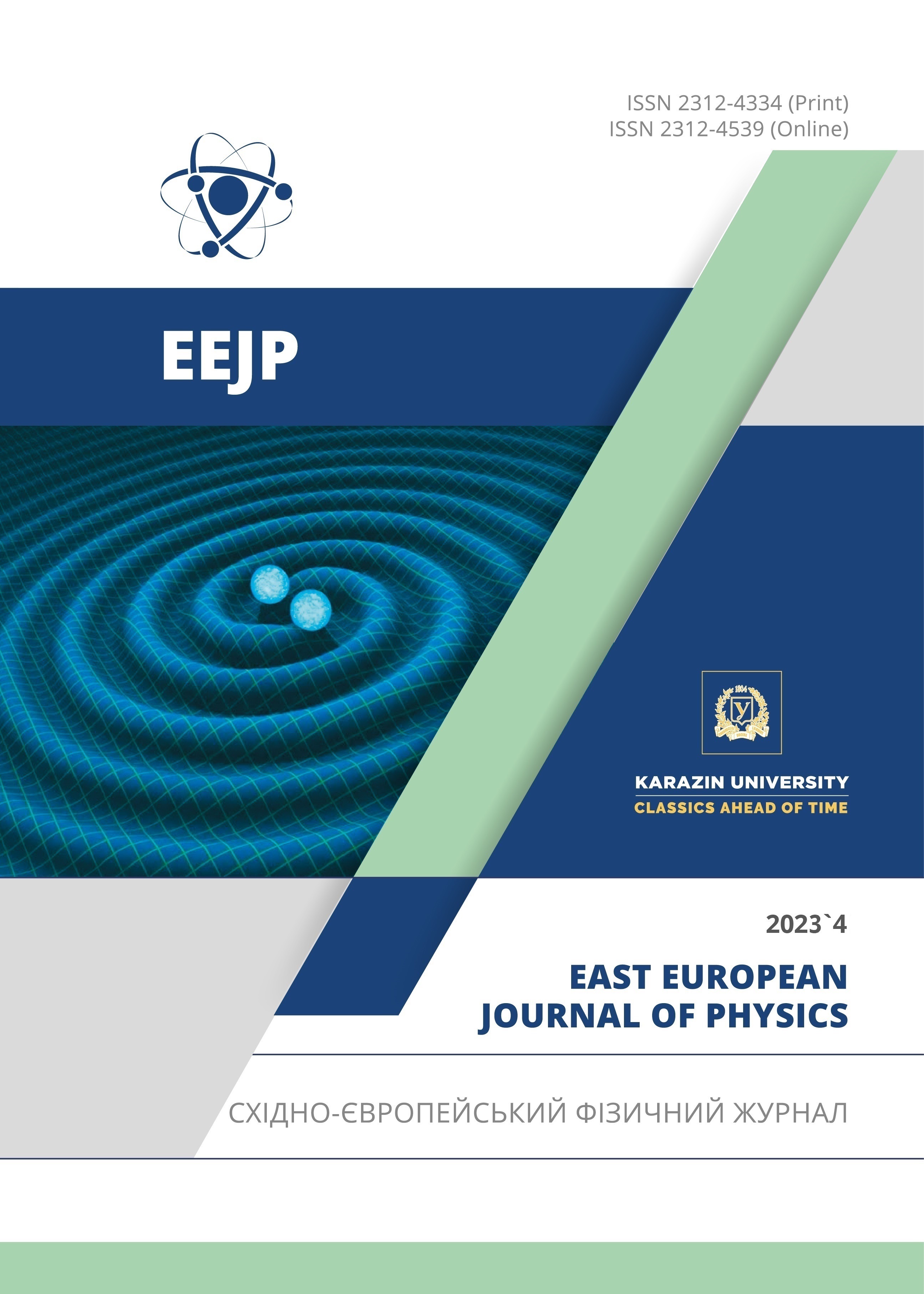Визначення структури та аналіз дефектів n-Si<Lu>, p-Si<Lu> за допомогою раманівської спектроскопії
Анотація
У даній роботі методом комбінаційного розсіяння досліджено леговані лютецієм зразки кремнію. Проведено реєстрацію та ідентифікацію компонентів як кристалічної, так і аморфної фаз у зразках. Спостерігається деяке порушення в спектрах комбінаційного розсіювання світла зразків кремнію, легованого лютецієм, порівняно з вихідним зразком. Встановлено, що інтенсивність комбінаційного розсіювання легованих зразків у 2-3 рази перевищує розсіювання кремнію. Порівняння проведено для інтенсивностей, пов'язаних з інтенсивностями однофононної лінії кремнієвої підкладки. Цей ефект спектрів комбінаційного розсіювання в діапазоні 930 см-1 – 1030 см–1, що з’являється в цьому діапазоні, подібний до зменшення даних для розповсюдження мультифононів на кремнії. Для отриманих зображень (n-Si<Lu> і p-Si<Lu>) смуги в атомному діапазоні комбінаторного розсіяння мають змішаний широкий і овальний фон в діапазоні від 623 см-1 до 1400 см-1. Цей фон може змінювати форму спостережуваних смуг.
Завантаження
Посилання
S.B. Utamuradova, S.Kh. Daliev, S.A. Muzafarova, and K.M. Fayzullaev, “Effect of the Diffusion of Copper Atoms in Polycrystalline CdTe Films Doped with Pb Atoms,” East Eur. J. Phys. 3, 385 (2023), https://doi.org/10.26565/2312-4334-2023-3-41
B.E. Egamberdiev, Sh.B. Utamurodova, S.A. Tachilin, M.A. Karimov, K.Yu. Rashidov, A.R. Kakhramonov, M.K. Kurbanov, et al., Applied Solar Energy, 58(4), 490 (2022). https://doi.org/10.3103/S0003701X22040065
S.B. Utamuradova, S.Kh. Daliev, E.M. Naurzalieva, X.Yu. Utemuratova, “Investigation of Defect Formation in Silicon Doped with Silver and Gadolinium Impurities by Raman Scattering Spectroscopy,” East Eur. J. Phys. 3, 430 (2023), https://doi.org/10.26565/2312-4334-2023-3-47
N.F. Zikrillaev, G.A. Kushiev, S.V. Koveshnikov, B.A. Abdurakhmanov, U.K. Qurbonova, and A.A. Sattorov, “Current Status of Silicon Studies with GexSi1-x Binary Compounds and Possibilities of Their Applications in Electronics,” East Eur. J. Phys. 3, 334 (2023), https://doi.org/10.26565/2312-4334-2023-3-34
Sh.B. Utamuradova, A.V. Stanchik, K.M. Fayzullaev, and B.A. Bakirov, “Raman scattering of light by silicon single crystals doped with chromium atoms,” Applied Physics, (2), 33–38 (2022). https://applphys.orion-ir.ru/appl-22/22-2/PF-22-2-33_EN.pdf
Sh.B. Utamuradova, and D.A. Rakhmanov, “Effect of Holmium Impurity on the Processes of Radiation Defect Formation in n-Si,” Annals of the University of Craiova, Physics, 32, 132–136 (2022). https://cis01.central.ucv.ro/pauc/vol/2022_32/15_PAUC_2022_132_136.pdf
M.B. Gongalsky, N.V Pervushin, D.E. Maksutova, U.A. Tsurikova, P.P. Putintsev, O.D. Gyuppenen, Y.V Evstratova, et al., “Optical Monitoring of the Biodegradation of Porous and Solid Silicon Nanoparticles,” Nanomaterials, 11, 2167 (2021) https://doi.org/10.3390/nano11092167
Z.T. Azamatov, Sh.B. Utamuradova, M.A. Yuldoshev, and N.N. Bazarbaev. “Some properties of semiconductor-ferroelectric structures,” East Eur. J. Phys. 2, 187-190 (2023), https://doi.org/10.26565/2312-4334-2023-2-19
Kh.S. Daliev, Sh.B. Utamuradova, I.Kh. Khamidzhonov, A.Zh. Akbarov, I.K. Mirzairova, and Zh. Akimova,” Thermally Induced Deep Centers in Silicon Doped with Europium or Lanthanum,” Inorganic Materials, 37(5), 436-438 (2001). https://doi.org/10.1023/A:1017556212569
K.P. Abdurakhmanov, Sh.B. Utamuradova, Kh.S. Daliev, S.G. Tadjy-Aglaeva, and R.M. Érgashev, “Defect-formation processes in silicon doped with manganese and germanium,” Semiconductors, 32(6), 606–607 (1998). https://doi.org/10.1134/1.1187448
M. Borowicz, W. Latek, A. Rzodkiewicz, A. Laszcz, Czerwinski, and J. Ratajczak, “Deep ultraviolet Raman investigation of silicon oxide: thin film on silicon substrate versus bulk material,” Advances in Natural Sciences: Nanoscience and Nanotechnology, 3, 045003 (2012). https://doi.org/10.1088/2043-6262/4/045003
P.A. Temple, and C.E. Hathaway, “Multiphonon Raman spectrum of silicon,” Physical Review B, 7(8), 3685–3697 (1973). https://doi.org/10.1103/PhysRevB.7.3685
A.G. Revesz, and H.L. Hughes, “The structural aspects of non-crystalline SiO2 films on silicon: a review,” Journal of Non-Crystalline Solids, 328(1-3), 48–63 (2003). https://doi.org/10.1016/S0022-3093(03)00467-8
K.J. Kingma, and R.J. Hemley, “Raman spectroscopic study of microcrystalline silica,” American Mineralogist, 79(3-4), 269 273 (1994). https://pubs.geoscienceworld.org/msa/ammin/article-pdf/79/3-4/269/4209223/am79_269.pdf
G.E. Walrafen, Y.C. Chu, and M.S. Hokmabadi, “Raman spectroscopic investigation of irreversibly compacted vitreous silica,” The Journal of Chemical Physics, 92(12), 6987–7002 (1990). https://doi.org/10.1063/1.458239
B. Champagnon, C. Martinet, M. Boudeulle, D. Vouagner, C. Coussa, T. Deschamps, and L. Grosvalet, “High pressure elastic and plastic deformations of silica: in situ diamond anvil cell Raman experiments,” Journal of Non-Crystalline Solids, 354(2-9), 569–573 (2008). https://doi.org/10.1016/j.jnoncrysol.2007.07.079
Sh.B. Utamuradova, Kh.S. Daliev, E.K. Kalandarov, and Sh.Kh. Daliev, “Features of the behavior of lanthanum and hafnium atoms in silicon,” Technical Physics Letters, 32(6), 469–470 (2006). https://doi.org/10.1134/S1063785006060034
Авторське право (c) 2023 Ходжакбар С. Далієв, Шаріфа Б. Утамурадова, Завкіддін Е. Бахронкулов, Алішер Х. Хаітбаєв, Джонібек Дж. Хамдамов

Цю роботу ліцензовано за Міжнародня ліцензія Creative Commons Attribution 4.0.
Автори, які публікуються у цьому журналі, погоджуються з наступними умовами:
- Автори залишають за собою право на авторство своєї роботи та передають журналу право першої публікації цієї роботи на умовах ліцензії Creative Commons Attribution License, котра дозволяє іншим особам вільно розповсюджувати опубліковану роботу з обов'язковим посиланням на авторів оригінальної роботи та першу публікацію роботи у цьому журналі.
- Автори мають право укладати самостійні додаткові угоди щодо неексклюзивного розповсюдження роботи у тому вигляді, в якому вона була опублікована цим журналом (наприклад, розміщувати роботу в електронному сховищі установи або публікувати у складі монографії), за умови збереження посилання на першу публікацію роботи у цьому журналі.
- Політика журналу дозволяє і заохочує розміщення авторами в мережі Інтернет (наприклад, у сховищах установ або на особистих веб-сайтах) рукопису роботи, як до подання цього рукопису до редакції, так і під час його редакційного опрацювання, оскільки це сприяє виникненню продуктивної наукової дискусії та позитивно позначається на оперативності та динаміці цитування опублікованої роботи (див. The Effect of Open Access).








